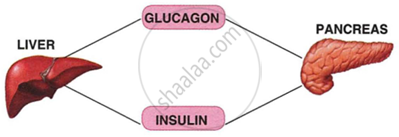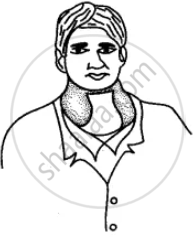Advertisements
Advertisements
Question
Differentiate hyperglycemia from hypoglycemia.
Solution
| Sr. No. | Hyperglycemia | Hypoglycemia |
| 1. | Elevation in the blood sugar level is called hyperglycemia | Decrease in the blood sugar level is called hypoglycemia. |
| 2. | This happens due to reduced secretion of insulin. | This happens due to increased secretion of insulin. |
RELATED QUESTIONS
Define the following:
Hormone
Fill in the blank:
Hormones are produced by ____________.
Define the following:
Endocrine glands
Draw an outline figure of the human body and show the location of different endocrine glands.
Mention which of the statements are true (T) and which are false (F). Give reason in support of your answer.
There are two kinds of diabetes (mild and severe) related with two different hormones.
Name the following:
The largest endocrine gland
Give the special function of the following:
Corpus luteum
Define the following:
Hypersecretion
What do you mean by endocrine system?
What is the chemical nature of hormone?
Is the following gland an exocrine or an endocrine gland?
Salivary gland
Given below is a table consisting of a set of items belonging to a common category. Complete the table by filling in the category and the odd one in the blanks
| Set | Category | Odd one |
| Adrenaline, Penicillin, Insulin, Thyroxin | __________ | __________ |
| Vasopressin, growth hormone, TSH, ACTH, FSH | __________ | __________ |
Organs like the stomach and intestine are also endocrine glands. Why?
Differentiate: Insulin and Glucagon.
Name the Following: Hormone secreted by corpus luteum.
Give the Technical Term: Name the blood vessels which transport hormones from the endocrine glands to the various parts of the body.
Give the Technical Term: What are releasing hormones?
Fill in the Blanks:
Nervous system and ______ are very closely related.
Given below is an outline of the human body showing the important glands.

(i) Name the glands marked 1 to 5.
(ii) Name the hormone secreted by 2. Give one important function of this hormone.
(iii) Name the endocrine cells present in part 3.
(iv) Name the hormone secreted by part 3. Give one important function of this hormone.
Study the diagram given below and then answer the questions that follow:
 |
- Name the cells of the pancreas that produce (1) glucagon (2) insulin.
- State the main function of (1) glucagon and (2) insulin.
- Why is the pancreas referred to as an exo-endocrine gland?
- Why is insulin not given orally but is injected into the body?
- What is the technical term for the cells of the pancreas that produce endocrine hormones?
- Where in the body is the pancreas located?
Given alongside are the diagrammatic sketches of some endocrine glands. Observe the figures and answer the following questions:

(i) Label the parts numbered 1 to 5.
(ii) Name the hormones secreted by (2) and (5).
(iii) Which chemicals in our body are greatly affected by hormones?
(iv) What is the chemical nature of hormones?
(v) Name the elements related to the functioning of hormones secreted by the structure (2) and (5).
The sketch below shows a certain condition in an individual:

(i) Name the condition.
(ii) What is the underlying cause of this condition?
(iii) Name two other conditions that could have resulted due to a similar cause.
(iv) Which hormone is required for iodine synthesis?
(v) Where is the thyroid gland located?
(vi) The hormone secreted by the thyroid gland is controlled from which hormone?
State the Location
Prostate gland
State the Function
Progesterone
Choose the Odd One Out
Choose the Odd One Out.
Choose the Odd One Out
Column ‘II’ is a list of items related to ideas in Column ‘I’. Match the term in Column ‘II’ with a suitable idea given in Column ‘I’.
| Column A | Column B |
| (i) Pituitary | (a) produces male sex characteristics |
| (ii) Ovaries | (b) decreases blood sugar level |
| (iii) Thyroid | (c) increases heart and breathing rate raises blood pressure |
| (iv) Thymus | (d) produces female sex characteristics |
| (v) Adrenals | (e) is known as emergency hormone |
| (vi) Hypothalamus | (f) regulates the level of calcium and phosphorus |
| (vii) Pancreas | (g) increases the rate of metabolism |
| (viii) Testes | (h) maintains the level of calcium |
| (ix) Parathyroid | regulates the amount of water excreted in the urine. |
| (x) Cretinism | (j) simulates skeletal growth |
| (xi) Diabetes mellitus | (k) regulates the activities of other glands |
| (xii) Insulin shock | (l) stimulates the development of male and female sex organs |
| (xiii) Gigantism | (m) Shortage of glucose in the blood. |
| (xiv) Enlargement of breasts in adult males | (n) Over-secretion of growth hormone |
| (xv) Exophthalmic goiter | (o) Excess of glucose in the blood |
| (xvi) Acromegaly | (p) Over-secretion of thyroxin |
| (xvii) Addison’s disease | (q) Dwarfism and mental retardation |
| (xviii)Cretinism | (r) Over-secretion of cortical hormones |
| (xix) Dwarfism | (s) Under-secretion of the adrenal cortex |
| (xx) Adrenalin | (t) Under-secretion of thyroxin in children |
| (xxi) Vasopressin | (u) Over-secretion of growth hormones in adults |
Vasopressin is concerned with:
Which organ acts a temporary endocrine gland in females?
Which of the following are exclusive endocrine glands?
Which of the following statement about sex hormones is correct?
A pregnant female delivers a baby who suffers from stunted growth, mental retardation, low intelligence quotient and abnormal skin. This is the result of ______.
Hormones are known as chemical messenger. Justify.
Label the endocrine glands in the given figure.

Which of the following organs in mammals does not consist of a central meduallary’ region surrounded by a cortical region?
Distinguish between Diabetes mellitus and Diabetes insipidus (endocrine gland concerned).
